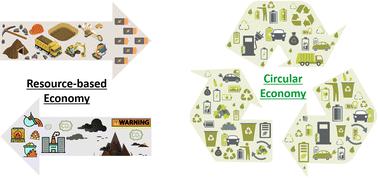当前位置:
X-MOL 学术
›
Energy Environ. Sci.
›
论文详情
Our official English website, www.x-mol.net, welcomes your
feedback! (Note: you will need to create a separate account there.)
Cathode regeneration and upcycling of spent LIBs: toward sustainability
Energy & Environmental Science ( IF 32.4 ) Pub Date : 2023-06-02 , DOI: 10.1039/d3ee00746d Xiang Xiao 1 , Li Wang 1 , Yingqiang Wu 1 , Youzhi Song 1 , Zonghai Chen 2 , Xiangming He 1
Energy & Environmental Science ( IF 32.4 ) Pub Date : 2023-06-02 , DOI: 10.1039/d3ee00746d Xiang Xiao 1 , Li Wang 1 , Yingqiang Wu 1 , Youzhi Song 1 , Zonghai Chen 2 , Xiangming He 1
Affiliation

|
‘Green ambition towards sustainability’ is one of the hot research topics of the 21st century. With the sharp steering of the energy infrastructure toward fulfilling this radical expectation, the last decade has seen a global trend toward diversified sustainable renewable energy sources (such as solar, wind, and hydroelectric power) and electrification. Lithium-ion batteries (LIBs) are playing a significant role in this energy revolution. However, with the massive scale of the production of LIBs and their eventual retirement, attention has been turned to the erratic supply of raw materials used to manufacture these batteries and their disposal. Cathode regeneration technology is likely to be an optimal solution for the disposal of waste cathodes, aimed at non-destructively repairing and straightforwardly reusing degraded cathode materials for re-manufacturing LIBs with a shortened circular process, reasonable profits, and excellent efficiency. Cathode upcycling technology, aimed at upgrading the electrochemical performance of degraded materials, can be well adapted to the upgrading of battery chemistry and show excellent flexibility and potential for transforming the LIB industry from a resource-based to a circular economy. Thus, a holistic perspective based on the complete life cycle of LIBs is encouraged, and sustainability must be at the forefront regarding battery and pack design, raw material acquisition, materials synthesis, manufacturing, operating, retiring, and recycling processes of LIBs.
中文翻译:

废锂离子电池的阴极再生和升级循环:迈向可持续发展
“实现可持续发展的绿色雄心”是21世纪的热门研究课题之一。随着能源基础设施的大力发展,以实现这一激进的期望,过去十年出现了多元化可持续可再生能源(如太阳能、风能和水力发电)和电气化的全球趋势。锂离子电池(LIB)在这场能源革命中发挥着重要作用。然而,随着锂离子电池的大规模生产及其最终的退役,人们的注意力已经转向用于制造这些电池的原材料的不稳定供应及其处置。阴极再生技术很可能是处理废阴极的最佳解决方案,旨在对退化的正极材料进行无损修复和直接再利用,以缩短循环流程、合理的利润和优异的效率。正极升级回收技术旨在提升降解材料的电化学性能,可以很好地适应电池化学的升级,并在锂离子电池行业从资源型经济向循环经济转型方面表现出优异的灵活性和潜力。因此,鼓励基于锂离子电池整个生命周期的整体视角,并且在锂电池的电池和电池组设计、原材料采购、材料合成、制造、运营、退役和回收过程中,可持续性必须处于最前沿。和卓越的效率。正极升级回收技术旨在提升降解材料的电化学性能,可以很好地适应电池化学的升级,并在锂离子电池行业从资源型经济向循环经济转型方面表现出优异的灵活性和潜力。因此,鼓励基于锂离子电池整个生命周期的整体视角,并且在锂电池的电池和电池组设计、原材料采购、材料合成、制造、运营、退役和回收过程中,可持续性必须处于最前沿。和卓越的效率。正极升级回收技术旨在提升降解材料的电化学性能,可以很好地适应电池化学的升级,并在锂离子电池行业从资源型经济向循环经济转型方面表现出优异的灵活性和潜力。因此,鼓励基于锂离子电池整个生命周期的整体视角,并且在锂电池的电池和电池组设计、原材料采购、材料合成、制造、运营、退役和回收过程中,可持续性必须处于最前沿。可以很好地适应电池化学的升级,并在锂离子电池产业从资源型经济向循环经济转型方面表现出良好的灵活性和潜力。因此,鼓励基于锂离子电池整个生命周期的整体视角,并且在锂电池的电池和电池组设计、原材料采购、材料合成、制造、运营、退役和回收过程中,可持续性必须处于最前沿。可以很好地适应电池化学的升级,并在锂离子电池产业从资源型经济向循环经济转型方面表现出良好的灵活性和潜力。因此,鼓励基于锂离子电池整个生命周期的整体视角,并且在锂电池的电池和电池组设计、原材料采购、材料合成、制造、运营、退役和回收过程中,可持续性必须处于最前沿。
更新日期:2023-06-02
中文翻译:

废锂离子电池的阴极再生和升级循环:迈向可持续发展
“实现可持续发展的绿色雄心”是21世纪的热门研究课题之一。随着能源基础设施的大力发展,以实现这一激进的期望,过去十年出现了多元化可持续可再生能源(如太阳能、风能和水力发电)和电气化的全球趋势。锂离子电池(LIB)在这场能源革命中发挥着重要作用。然而,随着锂离子电池的大规模生产及其最终的退役,人们的注意力已经转向用于制造这些电池的原材料的不稳定供应及其处置。阴极再生技术很可能是处理废阴极的最佳解决方案,旨在对退化的正极材料进行无损修复和直接再利用,以缩短循环流程、合理的利润和优异的效率。正极升级回收技术旨在提升降解材料的电化学性能,可以很好地适应电池化学的升级,并在锂离子电池行业从资源型经济向循环经济转型方面表现出优异的灵活性和潜力。因此,鼓励基于锂离子电池整个生命周期的整体视角,并且在锂电池的电池和电池组设计、原材料采购、材料合成、制造、运营、退役和回收过程中,可持续性必须处于最前沿。和卓越的效率。正极升级回收技术旨在提升降解材料的电化学性能,可以很好地适应电池化学的升级,并在锂离子电池行业从资源型经济向循环经济转型方面表现出优异的灵活性和潜力。因此,鼓励基于锂离子电池整个生命周期的整体视角,并且在锂电池的电池和电池组设计、原材料采购、材料合成、制造、运营、退役和回收过程中,可持续性必须处于最前沿。和卓越的效率。正极升级回收技术旨在提升降解材料的电化学性能,可以很好地适应电池化学的升级,并在锂离子电池行业从资源型经济向循环经济转型方面表现出优异的灵活性和潜力。因此,鼓励基于锂离子电池整个生命周期的整体视角,并且在锂电池的电池和电池组设计、原材料采购、材料合成、制造、运营、退役和回收过程中,可持续性必须处于最前沿。可以很好地适应电池化学的升级,并在锂离子电池产业从资源型经济向循环经济转型方面表现出良好的灵活性和潜力。因此,鼓励基于锂离子电池整个生命周期的整体视角,并且在锂电池的电池和电池组设计、原材料采购、材料合成、制造、运营、退役和回收过程中,可持续性必须处于最前沿。可以很好地适应电池化学的升级,并在锂离子电池产业从资源型经济向循环经济转型方面表现出良好的灵活性和潜力。因此,鼓励基于锂离子电池整个生命周期的整体视角,并且在锂电池的电池和电池组设计、原材料采购、材料合成、制造、运营、退役和回收过程中,可持续性必须处于最前沿。











































 京公网安备 11010802027423号
京公网安备 11010802027423号